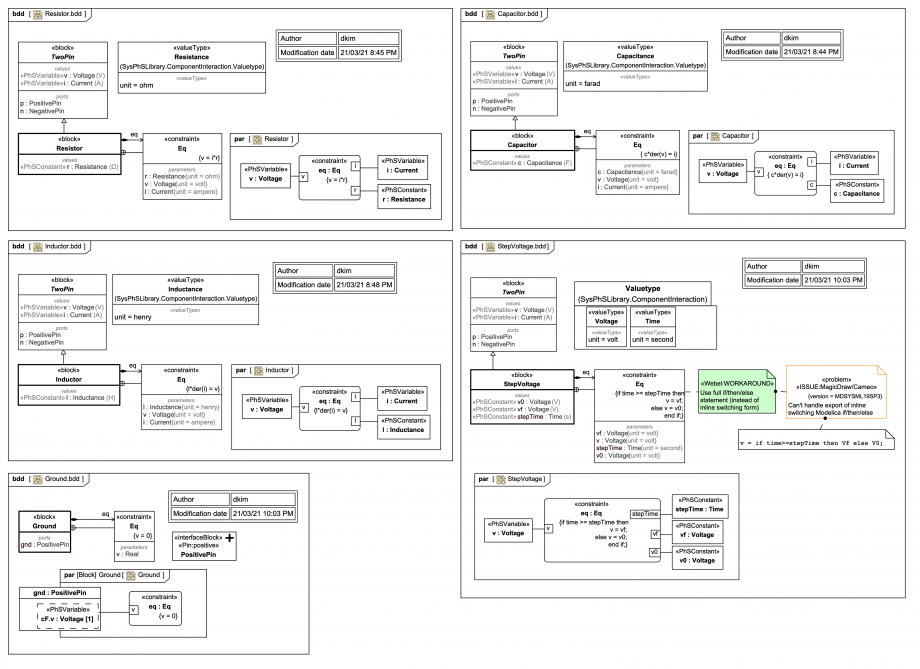Tags and keywords
The Modelica By Example target code is:
within ModelicaByExample.Components.Electrical.DryApproach;
model Resistor "A DRY resistor model"
parameter Modelica.SIunits.Resistance R;
extends TwoPin;
equation
v = i*R "Ohm's law";
end Resistor;
within ModelicaByExample.Components.Electrical.DryApproach;
model Capacitor "A DRY capacitor model"
parameter Modelica.SIunits.Capacitance C;
extends TwoPin;
equation
C*der(v) = i;
end Capacitor;
within ModelicaByExample.Components.Electrical.DryApproach;
model Inductor "A DRY inductor model"
parameter Modelica.SIunits.Inductance L;
extends TwoPin;
equation
L*der(i) = v;
end Inductor;
within ModelicaByExample.Components.Electrical.DryApproach;
model StepVoltage "A DRY step voltage source"
parameter Modelica.SIunits.Voltage V0;
parameter Modelica.SIunits.Voltage Vf;
parameter Modelica.SIunits.Time stepTime;
extends TwoPin;
equation
v = if time>=stepTime then Vf else V0;
end StepVoltage;
within ModelicaByExample.Components.Electrical.DryApproach;
model Ground "Electrical ground"
Modelica.Electrical.Analog.Interfaces.PositivePin ground "Ground pin"
annotation ...
equation
ground.v = 0;
end Ground;
Except for Ground they all reuse TwoPin from the previous diagram.
This SysML/SysPhS trail version uses slightly different and more concise naming.
The exported Modelica code (exported as usages to be shown in the next slide) is:
model StepVoltage
extends TwoPin;
parameter Voltage v0;
parameter Voltage vf;
parameter Time stepTime;
equation
if time>=stepTime then
v=vf;
else
v=v0;
end if;
end StepVoltage;
model Inductor
extends TwoPin;
parameter Inductance l;
equation
l*der(i)=v;
end Inductor;
model Capacitor
extends TwoPin;
parameter Capacitance c;
equation
c*der(v)=i;
end Capacitor;
model Resistor
extends TwoPin;
parameter Resistance r;
equation
v=i*r;
end Resistor;
model Ground
PositivePin gnd;
equation
gnd.v=0;
end Ground;
connector PositivePin
extends ChargeFlowElement;
end PositivePin;
connector NegativePin
extends ChargeFlowElement;
end NegativePin;
model TwoPin
PositivePin p;
NegativePin n;
Voltage v;
Current i;
equation
v=p.v-n.v;
i=p.i;
p.i+n.i=0;
end TwoPin;
connector ChargeFlowElement
flow Current i;
Voltage v;
end ChargeFlowElement;
type Voltage=Real(unit="V");
type Time=Real(unit="s");
type Inductance=Real(unit="H");
type Capacitance=Real(unit="F");
type Resistance=Real(unit="Ω");
type Current=Real(unit="A");
The Modelica By Example choice of PositivePin in Ground is not ideal, but it's reproduced in this SysML/SysPhS trail version anyway. If you look at the Modelica library version it has a more neutral basic pin:
model Ground "Ground node"
Interfaces.Pin p;
equation
p.v = 0;
end Ground;
connector Pin "Pin of an electrical component"
SI.ElectricPotential v "Potential at the pin";
flow SI.Current i "Current flowing into the pin";
end Pin;


